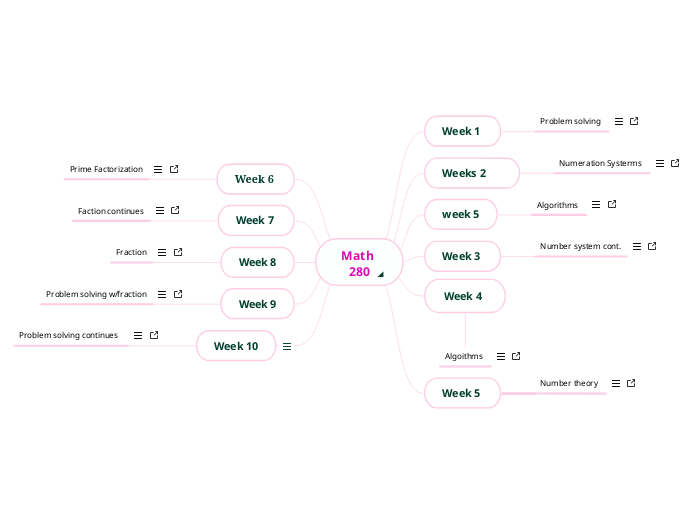Math 280^
Week 1
Problem solving
4 ways to solve a problem Understand Desire a plan George Poly made this Carry out the plan Strategy Look back-sense Device a planWhat problem-solving strategy are you going to use Guess and check/trial and error Draw a picture or a diagram make a table Act it out Make the problem simpler Look for a pattern Work backward Make an organized list Carry out the planCarrying out the plan usually than devising Be patient-most problems are not solved quickly nor on the first attempt If a plan does not work immediately, be persistent Do not let yourself get discouraged If one strategy does not work, try a different one
aWeeks 2
Numeration Systerms
Base -10system or Decimal Base -5: 0,1,2,3,4One= 5Five=525= 5(square)125= 5 times 3 221(base 5)= (2x25)+(2x5)+(1x1) = (2x5(2))+(2x5(1))+(1x5(0)) = 50+10+1 Use expanded notation In the expanded notation of a number, each digit is separated and written with its corresponding place value Example: 452 written in expanded notation as: 4x100+5x10+2x14= 4005= 5 tens 2= 2 units 1) 111 base 2 = (1x2(2))+(1x2(1))+(1x2(0)) = (1x4)+ (1x2) + (1x1) = 4+2+1=7
aweek 5
Algorithms
Division 15 cookies 3 on each plate 15 cookies 5 plates 15/5 15 cookies xxx= 15-3 =12xxx= 12-3=9xxx= 9-3=6xxx=6-3=3xxx=3-3=0Atternative algnithm 16/197 160-----------> 10 boxes 37 -16 ------------> 1 box -------- 21 -16 --------> 1box
aWeek 3
Number system cont.
Campare >,<,=are used to make comparisons in mathematics and programming.a) 34(base5) __<__34(base6)= (3x5)+4x5) 15+4=19b) 4(base7)_=__4(base8)= (4x7)=28 (4x8)=32c) 43(base5)___25(base6)=(4x5)+(3x5) (2x6) x (5x6)20+3=23 12+5= 17
aWeek 4
Algoithms
Adding American Standars NO place value R-->LThe last stepPartial Sums No place value R---> LPartial Sum w/place value R---> LThere is emphasis on place value Left- To- RightL to RExpanded notationRegrouping tens and onesPlace value Subtraction American StandardEuropean/MexcianReverse Indian Left to Right Expanded notation Interger Subtraction
aWeek 5
Number theory
Divisibility ruleType of numberFactors and multiples A number is divisible by a number if there is another number that meets this requirementBxC=A Ex. 10 divisible by 5 because 5x2=10 5x2=10Factor5 is a factor of 10 2 is a factor of 10 10 is divisible by 5 10 is divisible by 2 Ending Sum of Digitsby 2: 0,2,4,6,8 by 3: 120by 5: 0,5 by: 7,038 by 6: If it is divisible by both 2 and 3 Last 2 Digits 72,744 <---- yes because 44 goes into 4 824<-------- 24 goes into 4 Last 3 Digits by 8 7,239 <----- take the last 3 digits by 7:826 <----- Double the 6 By 11? "chop off
aWeek 6
Prime Factorization
Prime factorization 24 2 12 3 4 2 2 2= 2x2x2x3 Greatest Common Factor( GCF)Least Common Multiple (LCM)List Method Factors 24: 1,2,3,4,6,8,12,2436: 1,2,3,4,6,9,12,18,36GCF is (24,36)= 12 Multiple 24,48,72 36,72LCM(24,36)=72GCF (24,36)= 2x2x3=12LCM (24,36)= gcfx2x3 =12x2x3=72
aWeek 7
Faction continues
Hexagon 1/2 Trapezoid 2/4Rhombus 1/3 Triangle 1/6Mixed #: a number that has a whole and fractional part If you add fractions with the same shaped blocks!Turn into an improper fraction 3 1/2 3x2=6+1=7---> 7/2AddingGCF: 4,8,12,16,20,24 LCM: 6,12,18,241/4+1/6= 24 2/12+3/12= 5/12
aWeek 8
Fraction
Meaning Part of a whole Quotient -----> 3/4 = 3/4Ration -----> 20 students 15 girls 5 boys Ratio Part of a whole Ratio+fraction Models surface + area LengthSets( group of things)1 whole "pie"
aWeek 9
Problem solving w/fraction
3/4 class is girls, 2/3 have dark hair what fraction of the class is g+dh?2/3x3/4=6/12=1/2
aWeek 10
Problem Solving
Problem solving continues
Jim,Ken, Len and Max have a bag of miniature candy bars from trick-or treating together. Jim took 1/4 of the bars, and ken and len took 1/3 of all the bars. Max got the remaining 4 bars. How many bars were in the bag originally? Max 4 barsJim 1/4= 3/12 Ken 1/3= 4/12len 1/3All: 12x4= 48Jim: 3x4=12Ken: 4x4=16Len 4x4=16*go look at your notes for the examples
a